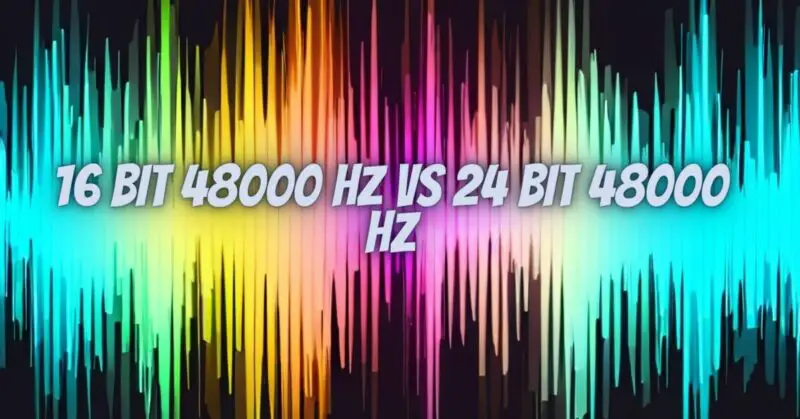Digital audio technology has evolved significantly, offering audiophiles and music enthusiasts a range of options to choose from when it comes to sound quality. Two common configurations are 16-bit 48kHz and 24-bit 48kHz. In this article, we will compare these two digital sound quality standards, examining their specifications, differences, and the impact they have on audio fidelity and recording.
Bit Depth and Sampling Rate: A Brief Overview
Before diving into the comparison, let’s clarify the concepts of bit depth and sampling rate, as they are fundamental to digital audio quality:
- Bit Depth: Bit depth represents the number of bits (binary digits) used to represent the amplitude of a sound wave. A higher bit depth allows for greater dynamic range and precision in capturing audio.
- Sampling Rate: Sampling rate, measured in kHz (kilohertz), refers to the number of samples (data points) taken per second to record audio. A higher sampling rate can capture more detail and higher frequencies in the audio signal.
Now, let’s compare 16-bit 48kHz and 24-bit 48kHz digital sound quality:
16-bit 48kHz: The Standard of CD Audio
- Bit Depth: 16-bit audio provides 65,536 possible amplitude values, resulting in a dynamic range of approximately 96 dB. This is the standard for CD audio and is considered high-quality for most music genres.
- Sampling Rate: A sampling rate of 48kHz captures audio frequencies up to 24kHz, covering the entire audible range of human hearing. It is the standard for CDs and is more than adequate for music playback.
- Dynamic Range: 16-bit audio provides a dynamic range that exceeds the capabilities of most consumer audio equipment, making it suitable for the majority of listening environments.
- File Size: 16-bit audio files are generally smaller in size compared to 24-bit audio, making them more manageable for storage and distribution.
24-bit 48kHz: Audiophile-Grade Precision
- Bit Depth: 24-bit audio provides a staggering 16.7 million possible amplitude values, resulting in a dynamic range of approximately 144 dB. This extended dynamic range allows for capturing the most subtle audio details and nuances.
- Sampling Rate: A sampling rate of 48kHz remains the same as in 16-bit audio, capturing audio frequencies up to 24kHz. However, the increased bit depth complements this sampling rate, resulting in greater precision.
- Dynamic Range: The extended dynamic range of 24-bit audio makes it ideal for audiophile-grade recordings and mastering processes. It can capture the quietest and loudest parts of a musical performance with exceptional accuracy.
- Audio Editing: 24-bit audio is preferred for professional audio editing and mastering, as it provides more headroom for processing without introducing quantization noise.
- File Size: 24-bit audio files are larger compared to 16-bit audio files due to the increased bit depth. This may require more storage space but is justified for audiophile and professional applications.
Choosing Between 16-bit and 24-bit 48kHz
Your choice between 16-bit 48kHz and 24-bit 48kHz should align with your specific audio needs:
- 16-bit 48kHz: Suitable for standard music playback, streaming, and most consumer audio setups. It offers excellent sound quality for typical listening environments and is compatible with a wide range of devices.
- 24-bit 48kHz: Ideal for audiophiles, professional audio production, and mastering. It provides unparalleled precision and dynamic range, making it essential for capturing and editing audio with the utmost fidelity.
In summary, the choice between 16-bit and 24-bit 48kHz depends on your listening preferences and the intended use of the audio. Both formats offer high-quality sound, but 24-bit audio excels in precision and dynamic range, making it the preferred choice for audiophile and professional applications.


